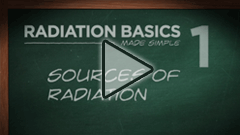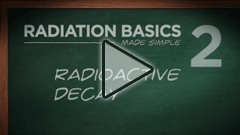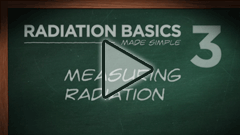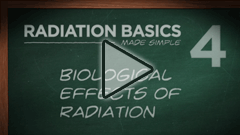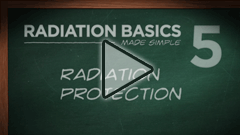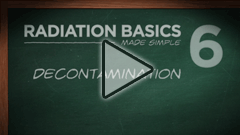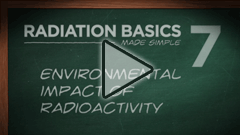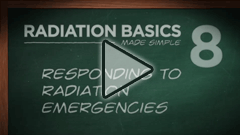Segment 1: Sources of Radiation
This segment introduces common sources of ionizing radiation and explains what makes radioactive atoms different from regular atoms.
At the end of this segment, viewers will be able to:
- Identify forms of radiation present in our natural environment
- Differentiate ionizing and non-ionizing radiation
- Compare properties of radioactive atoms and non-radioactive atoms
Segment 1 Quiz
- Radiation is:
-
- True or False: Visible light is a form of ionizing radiation.
-
- Radioactive isotopes, also known as radionuclides, are:
-
- Which of the following is an example of non-ionizing radiation?
-
- True or False: Ionizing radiation is less energetic than non-ionizing radiation.
-
- True or False: A radioactive atom is an atom with an unstable nucleus that emits radiation to achieve greater stability.
-
Segment 2: Radioactive Decay
This segment describes how radioactive atoms release radiation to reach a more stable state.
At the end of this segment, viewers will be able to:
- Explain how radioactive atoms release radiation to reach a more stable state
- Recognize the relationship between radioactive decay and half-life
- Compare properties of alpha particles, beta particles, and gamma rays
Segment 2 Quiz
- Match the term to its definition:
-
Term Definition  a.The spontaneous release of energy from an unstable atom.
a.The spontaneous release of energy from an unstable atom. b.A solid, liquid, or gas that gives off radiation.
b.A solid, liquid, or gas that gives off radiation. c.The energy that comes out of a radioactive atom.
c.The energy that comes out of a radioactive atom. d.The change from an unstable atom to a more stable atom by the emission of radiation.
d.The change from an unstable atom to a more stable atom by the emission of radiation. e.Radioactive atoms of the same element that have different numbers of neutrons.
e.Radioactive atoms of the same element that have different numbers of neutrons.
-
- Which of the following describes a radionuclide's half-life?
-
- Three types of radiation given off by radioactive atoms are:
-
Segment 3: Measuring Radiation
This segment describes common radiation measurements, the units used for these measurements, and different types of instruments that can detect radiation.
At the end of this segment, viewers will be able to:
- Identify common types of radiation measurements
- Recognize the units used for different radiation measurements
Segment 3 Quiz
- Common types of radiation measurements include:
-
- True or False: The amount of radioactivity and radiation levels do not necessarily correspond to the size, weight, and volume of the source of radiation.
-
- The international unit used to measure the amount of radioactivity is the:
-
- True or False: Ambient radiation levels are measured and reported in units of time and help to measure how much radiation is in the environment around us.
-
Segment 4: Biological Effects of Radiation
This segment describes radiation health effects and how our bodies react to radiation exposure.
At the end of this segment, viewers will be able to:
- Explain what can happen to a cell when it is damaged by radiation
- Describe how the radiation dose and dose rate affect the body
Segment 4 Quiz
- Which of the following statements about radiation are true?
-
- What can happen to a cell that is damaged by radiation?
-
- True or False: If a person receives a radiation dose over an extended period of time, the health impact will not be as severe as if the dose were received all at once.
-
- True or False: The health effects of radiation are the same no matter what the dose is or how fast the radiation dose is received.
-
- True or False: If a radiation dose is delivered to a portion of the body, the health impact will be more severe than if that dose was delivered to the whole body.
-
Segment 5: Radiation Protection
This segment introduces best practices for working safely with and around radioactive material and discusses ways to limit your radiation dose.
At the end of this segment, viewers will be able to:
- Identify basic protective measures to minimize radiation exposure
- Discuss the principle of ALARA (As Low As Reasonably Achievable)
Segment 5 Quiz
- Which of the following are basic protective measures that can be used to minimize radiation exposure?
-
- True or False: ALARA, as low as reasonably achievable, is a guiding principle for controlling exposure that can include any or all three protective actions: time, distance, and shielding.
-
- If responders find themselves on the scene of an accident that involves radioactive material, they can:
-
- Which of the following actions can you perform to limit your exposure in a radiation emergency?
-
- Which type of personal protective equipment measures radiation dose?
-
Segment 6: Decontamination
This segment describes ways to minimize or remove radioactive contamination.
At the end of this segment, viewers will be able to:
- Distinguish between external contamination and internal contamination
- Describe ways to remove radioactive contamination from hair, skin, or clothing
Segment 6 Quiz
- True or False: Radioactive material, just like any other matter, could be a solid, liquid, or gas.
-
- Which of the following statements is NOT true concerning contamination and exposure?
-
- Which of the following steps should you take if you have been contaminated with radioactive material?
-
Segment 7: Environmental Impact of Radioactivity
This segment discusses the environmental fate of radioactive contamination.
At the end of this segment, viewers will be able to:
- Describe how radioactive contamination can impact the environment
- Describe how natural environmental processes and active remediation contribute to environmental recovery after a radiation emergency
Segment 7 Quiz
- True or False: We are exposed to radiation constantly, but our bodies have not adapted to these everyday exposures.
-
- True or False: Radioactive contamination in the environment can impact soil, water, and air quality, enter the food chain and affect humans.
-
- True or False: Active remediation includes removing soil, cleaning surfaces and objects, and filtering water in order to reduce the amount of radioactive contamination in the environment.
-
- True or False: Natural processes like physical decay, dilution, and dispersion all contribute to early increases in radiation levels.
-
Segment 8: Responding to Radiation Emergencies
This segment introduces different types of radiation emergencies and discusses ways public health and partner agencies respond to these emergencies.
At the end of this segment, viewers will be able to:
- Distinguish between radiological and nuclear radiation emergencies
- Describe how public health and partner agencies respond to radiation emergencies
Segment 8 Quiz
- Which of the following is an example of a nuclear emergency:
-
- True or False: Two forms of radiological terrorism are radiological exposure devices (REDs) and strategic nuclear weapons.
-
- True or False: Population monitoring is the process of screening people for radioactive contamination, providing decontamination services, registering people for long-term follow-up, and referring those who need it for medical treatment.
-

